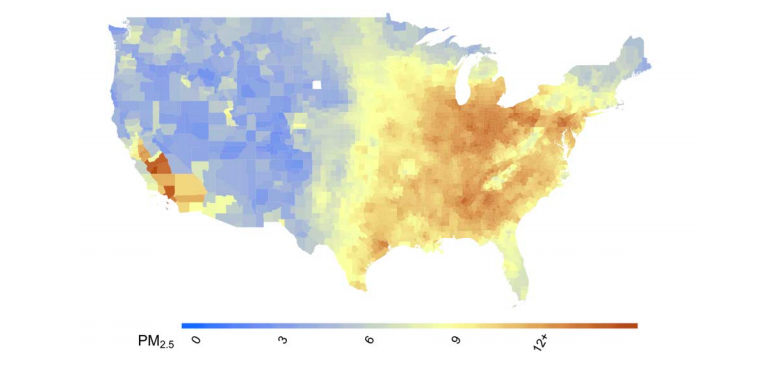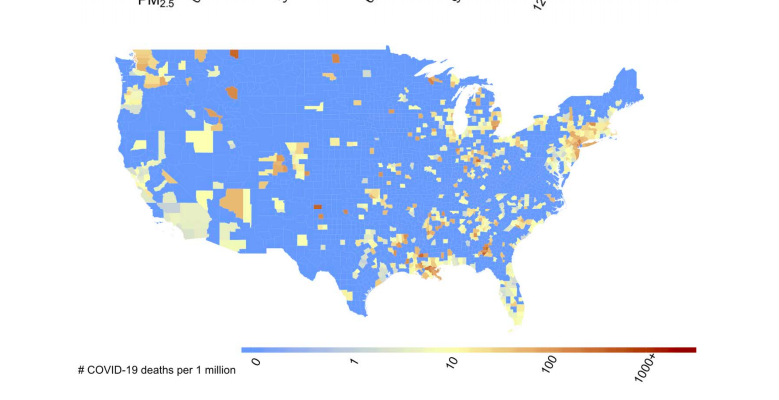There’s something especially insidious about an airborne threat to our health. In performing the most basic act of life — breathing — we let in what could kill us.
And yet, before the virus, we blithely exposed our lungs to another deadly threat — air pollution.
Last week, I drew a contrast between the extraordinarily expensive, economy-stopping measures we’ve taken against the pandemic and our acceptance of the outdoor air pollution that kills 4.2 million people every year.
Obviously, the pollution risks are more predictable and manageable than those of the disease, which is why we’ve tolerated the former. But these aren’t entirely separate threats.
Indeed, there’s mounting evidence that air pollution leaves us more vulnerable to the virus. It would be surprising if this wasn’t the case. Anything that stresses and damages lung tissue will weaken its resistance to infection.
A new study from the Department of Biostatistics at Harvard appears to confirm this intuition. The researchers found a “statistically significant and robust” link between exposure to fine particulate matter (one of the key components of air pollution) and the Covid-19 death rate.
The dirtiest air is often found in densely populated areas — especially in the poorest neighbourhoods, so the usual caveats about correlations and causation apply. However, the researchers did make adjustments for a number of factors such as “population size, hospital beds, number of individuals tested, weather and socioeconomic and behavioural variables including, but not limited to obesity and smoking” — and still reached the following conclusion:


Of course, it’s just one study from one country. But by the time this crisis is over we will have a mountain of data to analyse from across the world. If there’s a link between air pollution and Covid mortality, there’s a good chance of establishing it beyond reasonable doubt.
We’ll then be faced with two vital decisions: Firstly, whether we continue to tolerate this assault on our lungs; and secondly whether we make the polluters pay.








Join the discussion
Join like minded readers that support our journalism by becoming a paid subscriber
To join the discussion in the comments, become a paid subscriber.
Join like minded readers that support our journalism, read unlimited articles and enjoy other subscriber-only benefits.
SubscribeIf Governments are interested in reducing 60%, or more, the emission of PM and Pollutant Gases that the industrial process generates when using all kind of fossil fuels, like oil, gas, coal and iron ore, it should contact who has the technology Selective Switching that allows this reduction.
Selective Switching Technology – current scenario.
* Is being installed the 1st Upgrade in an industrial filter, model ESP -Electrostatic Precipitator – installed in Vitória/ES – Brasil, turning the ESP into the ESP-SS, with CERTIFICATION scheduled for October / 2020.
* This Upgrade will allow that can be retained 100% of PM 0.1 micron up to PM 10 micron which is currently not retained. This mass of Particulate Material that will be retained represents 60% of all current pollution not retained and released into the atmosphere.
* Parallel to this, is being designed and will be built the 1st ESP containing the Selective Switching technology, which will be the ESP-SS.
* Is under evaluation the use of an device, the ACI – Activated Carbon Injector – that will be installed in the ESP-SS, transforming it into the industrial filter to be called ESP-SS/ACI.
* This ESP-SS/ACI, able to filter and retain 100% of PM 0.1 micron to PM 10 micron, will also be capable of filtering and retaining an immense amount of Pollutant Gases produced in industrial processes, which today require retention systems of post-treatment, usually complex and very expensive.
* In a 2nd stage, only possible in 2 years, when it is ready the version of Relay LP 160 KV, fundamental piece of the Technology SS, produced in the UNITED STATES under license of TCS Ltda, the ESP-SS/ACI will be able to retain 100% of the total of all current mass of PMs and all types of Pollutant Gases released into the atmosphere through the chimneys, since PMs less than 0.1 micron will also be withheld.
The Patent holder, unfortunately being a small company, is selling the Patent to an Asian country, that has been quick and effective in verifying the quality of the Selective Switching Technology.
PS: My cell is 55 27 999820767
Regards.
Flavio Berthoud.
It does appear that Covid victims appear to be centred on areas with higher levels of pollution.
Well, there’s no air pollution now.